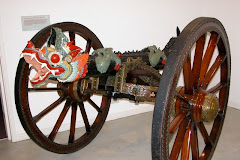Well, you almost certainly know how to do that already! If you have ever lobbed a ball over a wall to someone, you did it because you couldn't throw it directly - the wall was in the way. In lobbing it, you chose a trajectory that would clear the wall.
If there's nothing in the way, a soldier with a rifle simply aims directly at the target. The rifle can 'see' it and the bullet will follow a very 'flat' trajectory to the target. The same applies to a tank gunner: the gun can 'see' the target directly and the tank shell also follows a very flat trajectory to the target.
In the world of artillery, you frequently have to select a trajectory that will deliver a shell to a target when there's a hill in the way - in effect, you have to lob it over the hill. You may also have to deliver a shell to a target that is tucked away in a gully, where a normal trajectory is unable to reach it, so you need a high trajectory with a steep angle of descent. An ability to shape the trajectory to fit the conditions becomes an essential tool.
Have you ever handled a garden hose? If so, you will know how to shape trajectories using the same basic tools that an artilleryman uses - angle of elevation and pressure. You know that as you point the hose upwards, the water goes further down the garden - until you reach an angle of 45 degrees! After that, if you go on tilting the hose upwards, the watering point will start coming back towards you. If you point it at 90 degrees, which is directly upwards, you start to get wet!
Well, exactly the same happens with an artillery weapon. The range (distance) goes on increasing as you elevate the barrel of the gun until you reach that 45 degree mark. This part of the gun's performance is known as "low angle" firing. Above 45 degrees, the range starts to decrease just as it does with a hose. This is known as "high angle" firing.
But using a hose, you can also change the distance the water goes, even if you maintain the same angle of elevation. You simply turn the tap and change the water pressure. The higher the pressure, the further the water goes. In a gun, you change the pressure by adding or subtracting to the propelling charge. The larger the charge, the bigger the kick given to the shell and the faster it goes; so here, too, you can change the range without changing the angle of elevation.
With these two basic tools - angle of elevation and variation of charge - you can shape the trajectory to fit almost any situation. But note that I said "almost". There are often situations where a target cannot be reached from a given firing position and then you have to move the gun.




No comments:
Post a Comment